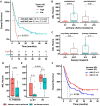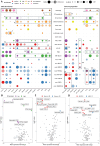AXL expression reflects tumor-immune cell dynamics impacting outcome in non-small cell lung cancer patients treated with immune checkpoint inhibitor monotherapy
- PMID: 39238637
- PMCID: PMC11375292
- DOI: 10.3389/fimmu.2024.1444007
AXL expression reflects tumor-immune cell dynamics impacting outcome in non-small cell lung cancer patients treated with immune checkpoint inhibitor monotherapy
Abstract
Introduction: AXL receptor expression is proposed to confer immune-checkpoint inhibitor (ICI)-resistance in non-small cell lung cancer (NSCLC) patients. We sought to interrogate AXL expression in conjunction with mutational and tumor-microenvironmental features to uncover predictive mechanisms of resistance in ICI-treated NSCLC patients.
Methods: Tumor samples from 111 NSCLC patients treated with ICI-monotherapy were analyzed by immunohistochemistry for tumor- and immune-AXL expression. Subsets of patients were analyzed by whole-exome sequencing (n = 44) and imaging mass cytometry (n = 14). Results were related to ICI-outcome measurements.
Results: Tumor-cell AXL expression correlated with aggressive phenotypic features including reduced OS in patients treated with ICIs (P = 0.04) after chemotherapy progression, but conversely associated with improved disease control (P = 0.045) in ICI-treated, PD-L1 high first-line patients. AXL+ immune-cell infiltration correlated with total immune-cell infiltration and improved overall outcomes (PFS: P = 0.044, OS: P = 0.054). Tumor-cell AXL-upregulation showed enrichment in mutations associated with PD-L1-upregulation and ICI-response such as MUC4 and ZNF469, as well as adverse mutations including CSMD1 and LRP1B which associated with an immune-suppressed tumor phenotype and poor ICI prognosis particularly within chemotherapy-treated patients. Tumor mutational burden had no effect on ICI-outcomes and was associated with a lack of tumor-infiltrating immune cells. Spatial-immunophenotyping provided evidence that tumor-cell AXL-upregulation and adverse mutations modulate the tumor microenvironment in favor of infiltrating, activated neutrophils over anti-tumor immune-subsets including CD4 and CD8 T-cells.
Conclusion: Tumor-cell AXL-upregulation correlated with distinct oncotypes and microenvironmental immune-profiles that define chemotherapy-induced mechanisms of ICI-resistance, which suggests the combination of AXL inhibitors with current chemoimmunotherapy regimens can benefit NSCLC patients.
Keywords: AXL receptor tyrosine kinase; NSCLC; biomarker; immunotherapy resistance; tumor microenvironment.
Copyright © 2024 Rayford, Gärtner, Ramnefjell, Lorens, Micklem, Aanerud and Engelsen.
Conflict of interest statement
JL and DM are founders of BerGenBio ASA. JL and AR were previously employed by BerGenBio ASA, and DM is currently employed by BerGenBio ASA. The remaining authors declare that the research was conducted in the absence of any commercial or financial relationships that could be construed as a potential conflict of interest.
Figures






Similar articles
-
Integration of comprehensive genomic profiling, tumor mutational burden, and PD-L1 expression to identify novel biomarkers of immunotherapy in non-small cell lung cancer.Cancer Med. 2021 Apr;10(7):2216-2231. doi: 10.1002/cam4.3649. Epub 2021 Mar 2. Cancer Med. 2021. PMID: 33655698 Free PMC article.
-
Single or combined immune checkpoint inhibitors compared to first-line platinum-based chemotherapy with or without bevacizumab for people with advanced non-small cell lung cancer.Cochrane Database Syst Rev. 2020 Dec 14;12(12):CD013257. doi: 10.1002/14651858.CD013257.pub2. Cochrane Database Syst Rev. 2020. Update in: Cochrane Database Syst Rev. 2021 Apr 30;4:CD013257. doi: 10.1002/14651858.CD013257.pub3. PMID: 33316104 Free PMC article. Updated.
-
Single or combined immune checkpoint inhibitors compared to first-line platinum-based chemotherapy with or without bevacizumab for people with advanced non-small cell lung cancer.Cochrane Database Syst Rev. 2021 Apr 30;4(4):CD013257. doi: 10.1002/14651858.CD013257.pub3. Cochrane Database Syst Rev. 2021. PMID: 33930176 Free PMC article.
-
Mutation-guided chemotherapy-free strategy in first-line immunotherapy for low PD-L1-expressing non-squamous NSCLC.J Immunother Cancer. 2024 Nov 29;12(11):e009693. doi: 10.1136/jitc-2024-009693. J Immunother Cancer. 2024. PMID: 39615893 Free PMC article.
-
Elucidation of the relationships of MET protein expression and gene copy number status with PD-L1 expression and the immune microenvironment in non-small cell lung cancer.Lung Cancer. 2020 Mar;141:21-31. doi: 10.1016/j.lungcan.2020.01.005. Epub 2020 Jan 7. Lung Cancer. 2020. PMID: 31931443
Cited by
-
Recent advances in TAM mechanisms in lung diseases.J Transl Med. 2025 Apr 26;23(1):479. doi: 10.1186/s12967-025-06398-2. J Transl Med. 2025. PMID: 40287707 Free PMC article. Review.
-
Axl inhibitor-mediated reprogramming of the myeloid compartment of the in vitro tumor microenvironment is influenced by prior targeted therapy treatment.Front Immunol. 2025 Jun 5;16:1601420. doi: 10.3389/fimmu.2025.1601420. eCollection 2025. Front Immunol. 2025. PMID: 40539073 Free PMC article.
-
The Role of Axl Inhibition and Immune Checkpoint Blockade in Non-small Cell Lung Cancer: Current Understanding and Treatment Strategies.Cancer Diagn Progn. 2025 Jun 30;5(4):417-428. doi: 10.21873/cdp.10455. eCollection 2025 Jul-Aug. Cancer Diagn Progn. 2025. PMID: 40600224 Free PMC article. Review.
-
An Organoid Model for Translational Cancer Research Recapitulates Histoarchitecture and Molecular Hallmarks of Non-Small-Cell Lung Cancer.Cancers (Basel). 2025 Jun 3;17(11):1873. doi: 10.3390/cancers17111873. Cancers (Basel). 2025. PMID: 40507353 Free PMC article.
References
MeSH terms
Substances
LinkOut - more resources
Full Text Sources
Medical
Research Materials
Miscellaneous

